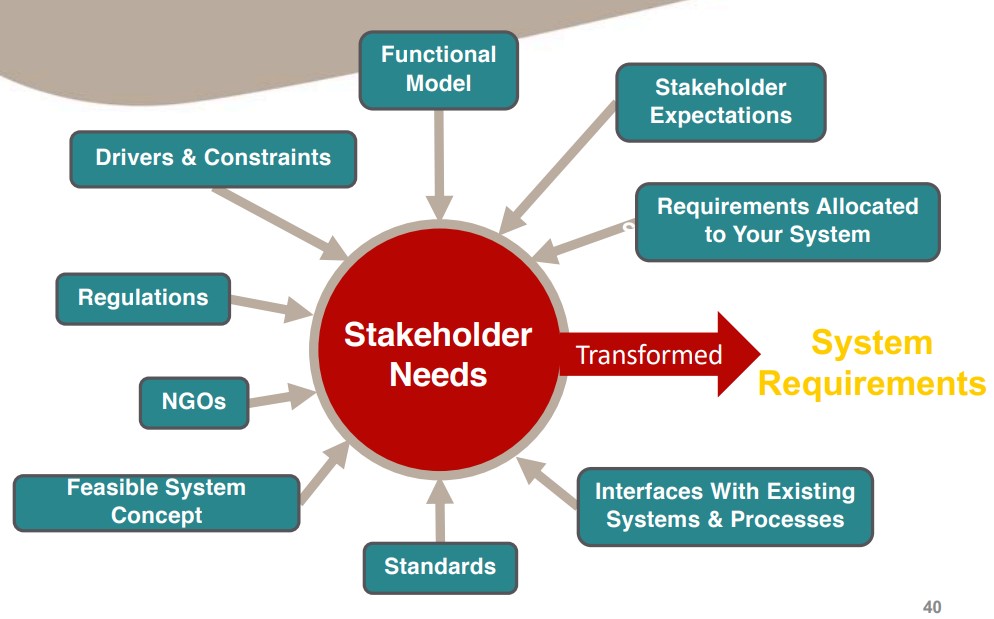Welcome to the pivotal world of Systems Engineering, where the transformation of stakeholder needs into technical requirements forms the cornerstone of successful system development. Bridging the gap between what users expect and what engineers design is both an art and a science, requiring a meticulous process to ensure every need translates into a functional component of the final system.
This process is not just about meeting expectations—it’s about capturing the essence of what’s necessary and making it a tangible reality. Join us as we delve into the intricacies of this transformation, setting the stage for innovative solutions that meet and exceed the aspirations of all stakeholders involved.
Table of Contents
Understanding Stakeholder Needs
In the landscape of system development, identifying and interpreting stakeholder needs is a process that cannot be overlooked. These needs emerge from various origins – from scope definition to external factors like regulations, standards, and inputs from non-governmental organizations (NGOs). Recognizing the multifaceted nature of these sources is crucial for creating a comprehensive needs profile.
Defining ‘Stakeholder Needs’
The term ‘stakeholder needs’ refers to the expectations and requirements of all parties involved or affected by the system. They encapsulate the desired capabilities, performance, and constraints that the system must address. Ensuring these needs are well-understood sets the foundation for a successful transformation into detailed technical requirements, forming the blueprint for systems integration and development.
Significance of Formal Transformation
It is through formal transformation that these diverse needs congeal into a cogent set of objectives. This step is not merely a translation but a critical analysis ensuring that every need aligns with the overall goal of creating a feasible and valid system. With active engagement and a collaborative approach, this translation forms the bedrock of innovation, ensuring that the final system is not just built, but built right, fulfilling its intended purpose within its operational environment.

Characteristics of a Robust Set of Needs
Crafting a robust set of stakeholder needs is integral to system development, embodying a blueprint that ensures the end product aligns with expectations. Only when these needs are comprehensive, clear, feasible, and verifiable do they pave the way for a successful transformation into technical requirements.
Completeness and Consistency
A well-defined set of needs is complete, standing independently to cover all necessary functionalities and performance metrics. It also must exhibit consistency, with no contradictory requirements or ambiguous language that could cloud interpretation. Employing a standard terminology throughout the document further safeguards against misunderstandings, maintaining uniformity across the board.
Clarity and Feasibility
Each need should be comprehensible, articulated in a manner that stakeholders can readily grasp, illuminating the path forward for the system. Moreover, needs must be feasible, meaning they are achievable within the given constraints—technical, financial, legal, and ethical—and carry an acceptable level of risk. It’s a delicate balance to strike, but essential for realizing practical solutions.
Verifiability
Lastly, the ability to validate these needs is paramount—they need to be testable against the agreed-upon concept, ensuring that, upon delivery, the system meets its goals within its operational environment. Only then can the system be considered a success, with stakeholder needs transformed into an effective and functioning reality.
Defining a Strong Foundation: Stakeholder Needs
For systems engineers and stakeholders alike, understanding the key characteristics that define a robust set of needs is crucial. Such a set forms the bedrock for successful system design and implementation. Below is a detailed table outlining these characteristics, offering insights into their importance, benefits, and considerations that should be kept in mind to ensure they are effectively incorporated into the systems engineering process.
| Characteristic | Description | Benefits | Key Considerations |
|---|---|---|---|
| Complete | Encompasses all necessary functionalities and descriptions required for the system. | Prevents scope creep and ensures all critical aspects are considered. | Regularly revisit to confirm if additional needs arise during the lifecycle. |
| Consistent | Free from conflicting statements and employs uniform terminology. | Reduces misunderstandings and streamlines communication among stakeholders. | Consistency checks in reviews and utilizing a controlled vocabulary. |
| Comprehensible | Articulated clearly so all stakeholders can understand the expectations. | Enhances stakeholder buy-in and supports effective requirement prioritization. | Simplify technical jargon; employ visuals where appropriate. |
| Feasible | Achievable within the given constraints and carries an acceptable level of risk. | Ensures project viability and promotes realistic expectation setting. | Assess against available resources, current technology, and risk profiles. |
| Able to be Validated | Capable of being proven through testing that the needs have been met. | Builds confidence in the system’s ability to fulfill its intended purpose. | Define clear, measurable criteria for successful validation early on. |
The Transformation Process: From Needs to Requirements
The essence of systems engineering lies in the meticulous translation of stakeholder needs into actionable technical requirements. This pivotal transformation demands a deep understanding of the distinction between what stakeholders desire and what the system must deliver to satisfy those desires.
Distinguishing Stakeholder Needs from Technical Requirements
While stakeholder needs reflect the expectations and desires of those invested in the system’s success, technical requirements serve as the definitive parameters that guide the development and operation of the system. They offer a system perspective that aligns with the possibilities and constraints of current technology, legal stipulations, and cost considerations.
Developing Technical Requirements
Translating these needs into requirements involves two primary actions: decomposition and derivation. Decomposition breaks down broad needs into granular, specific requirements. Derivation, on the other hand, draws out implicit needs that may not have been explicitly stated but are essential to functionality or compliance. By continually asking, “What does the system have to do to satisfy this need?” engineers can ensure that the outcomes align closely with stakeholder visions, paving the way for systems that are not only operational but optimal.
Common Techniques and Tools
To successfully navigate the journey from stakeholder needs to technical requirements, systems engineers leverage a variety of techniques and tools. These resources enhance clarity, reduce complexity, and ensure a streamlined requirements management process.
Functional Analysis
Functional analysis is a technique used to break down complex processes and systems into manageable parts. By understanding each function individually, engineers can map out how each element contributes to the system’s overall objective, ensuring that all stakeholder needs are addressed without redundancies.
Requirements Management Software
Advancements in requirements management software provide platforms that facilitate the capture, tracking, and organization of requirements. These systems promote consistency and traceability throughout the development cycle, and support collaboration among multi-disciplinary teams, leading to greater alignment and a shared vision of the final product.
Applying these robust methodologies and cutting-edge tools positions systems engineers to not only meet but exceed stakeholder expectations. By maintaining an unyielding focus on the foundational needs, the stage is set for the successful realization of complex systems that adhere to demanding specifications and constraints.
Case Studies and Examples
To concretize the importance of transforming stakeholder needs into technical requirements, let’s delve into an extended case study: the development of a state-of-the-art smart home automation system aimed at delivering user-friendly operation and energy efficiency.
Extended Case Study: Smart Home Automation System
Imagine the stakeholders outline their primary needs for a smart home system that can be operated easily by all household members and that contributes to significant energy savings.
Here’s how these needs were systematically transformed into actionable technical requirements:
- User Friendly Interface: The need for easy operation led to a requirement for a highly intuitive mobile and voice-controlled interface compatible with various OS platforms.
- Remote Access: Stakeholders’ desire for remote capabilities necessitated requirements for solid cybersecurity measures to protect user data and privacy.
- Energy Efficiency: The demand for energy savings resulted in requirements for integration of smart meters and AI-based algorithms to optimize energy consumption across devices.
- Device Compatibility: To fulfill the need for compatibility, a requirement was outlined for a modular approach in the communication protocol, supporting current and future devices.
- Automation Features: Derived from the broad goal of convenience, requirements were created for motion sensors, programmable schedules, and adaptive learning functionalities of user patterns.
The development process was meticulously documented and monitored using advanced requirements management software, ensuring every technical requirement stayed aligned with stakeholder expectations and project resources.
Upon completion, the system underwent rigorous validation, confirming it met the intended purpose — a testament to the success of transforming stakeholder needs into a fully-functional and validated smart home automation solution.
Conclusion
As this exploration of stakeholder needs transformation into technical requirements concludes, we can affirm the vital role this process plays in systems engineering. The structured journey from elucidating comprehensive needs to crafting precise requirements ensures that every project not only fulfills its functional criteria but also aligns perfectly with stakeholder visions. This clear translation is indicative of an engineering triumph — the creation of a system where all components integrate seamlessly to deliver optimal performance within defined constraints.
Reflection on Systems Engineering
Systems engineering champions the intricate art of balance—balancing stakeholder expectations with technical realities, balancing innovative design with practical application, and balancing project deliverables within time and budget constraints. The harmony achieved through this balance is what brings complex systems to life, meeting the demands of today and paving the way for the advances of tomorrow.
So, let us remember that behind every successful system, there is a meticulous process where needs and requirements converge, setting the foundation for excellence in engineering solutions. May this discussion on transforming stakeholder needs into technical requirements serve as a guiding beacon for all current and future systems engineering endeavors.







